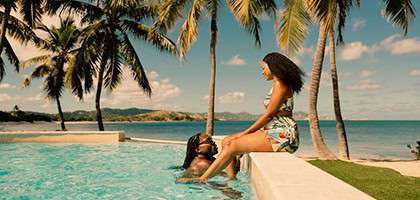Must-Visit Cultural Attractions
Experience the rich cultural tapestry of the U.S. Virgin Islands, where history, art and tradition come alive on every corner. From the historic streets of Charlotte Amalie to lively festivals celebrating local heritage, there’s something for everyone to explore. Don’t miss the chance to immerse yourself in the unique cultural attractions that make the U.S. Virgin Islands a true Caribbean treasure.
ST. CROIX
Constructed between 1738 – 1749 by enslaved Africans alongside Danish soldiers during the Danish occupation of St. Croix, Fort Christiansvaern was designed to protect the island from potential invaders and possibly even pirates. The fort also served as a Custom House, collecting taxes on the imported goods that once arrived on the many ships that anchored in Christiansted Harbor. Today, the fort is part of the Christiansted National Historic Site, one of the best-preserved historical sites in the Caribbean. Set off on a guided tour to see the cannon-filled courtyard, prison cells and officers’ barracks. A small museum explores the history of the fort, the town of Christiansted and colonial life on the island of St. Croix.
The Cruzan Rum Distillery, established in 1760, is known for its smooth, high-quality rums. The distillery offers guided walking tours that take visitors through the process of turning molasses into rum at the oldest still-functioning distillery in the Virgin Islands. After the tour, guests can visit the Sampling Bar to taste a variety of rums and sip signature cocktails.
Set off on a docent- or self-guided tour of Little La Grange Farm & Lawaetz Museum, a certified organic farm established in 2015 on a historic 18th-century sugar and cattle plantation. You’ll learn about the rich heritage of the Lawaetz family, who migrated to St. Croix from Denmark in 1890. Visitors will see organic farming in action on this scenic working farm, and can also purchase freshly picked fruits, greens and vegetables from the on-site shop.
The 12-acre Estate Whim Museum was once a working sugar plantation. Today, it’s a living museum where visitors can meet and learn from St. Croix’s tradition bearers as they share their music, food and artisan traditions. Explore the colonial-era Great House, mill factory complex and rotating cultural exhibits for a glimpse into the island’s colonial history. At the Estate Whim Research Library and Archives, visitors can conduct genealogical and historical research from the museum’s vast archives.
ST. JOHN
The colonial-era Peace Hill Windmill offers stunning views of Hawksnest Bay to the west, and Denis Bay and Trunk Bay to the east. Once a working windmill used for sugar production here at the former Denis Bay Plantation, today the site hosts community meditation gatherings every Sunday at sunset.
For a deeper understanding of the oppression, resistance and culture of the enslaved peoples that once lived on St. John, take a self-guided tour of the 18th-century Annaberg Sugar Plantation Ruins‘ former enslaved peoples’ quarters, sugar factory complex, animal mill and windmill. You’ll learn how the global sugar market drove the spread of colonialism in the Virgin Islands.
The Reef Bay Trail and Sugar Plantation in Virgin Islands National Park offer a rich blend of natural beauty and historical intrigue. Hike the 2.2-mile-long trail through the forest and past the remains of four sugar estates, including the impressive Reef Bay Sugar Estate with its old buildings and steam-powered machinery. A side trail at mile 1.6 leads to a waterfall and petroglyphs attributed to the early Taino Indians. The trail ends at a beautiful, pristine beach where you can relax and take a dip in the ocean. If you prefer a guided experience, join a National Park Service ranger-led hike to learn more about the area’s natural and cultural history.
Housed in the restored Enighed Estate House that dates back to 1757, the Elaine Ione Sprauve Public Library & Museum of Cultural Arts boasts a collection of books, old photographs, newspaper clippings and paintings that offer insight into the island’s past. A dedicated reading area for children hosts a weekly story time.
ST. THOMAS
The Three Queens Statue commemorates the courageous female leaders of the 1878 Fireburn labor riot. The statue honors three heroic women — Queen Mary, Queen Agnes and Queen Josiah — who led an insurrection against the Danish government, demanding better working and living conditions for laborers. The Three Queens Statue is located just below Blackbeard’s Castle near the Emancipation Garden, a historic park commemorating the freeing of enslaved peoples.
Founded in 1796, The Hebrew Congregation of St. Thomas Synagogue has its home in one of the oldest synagogues in continuous use in the Western Hemisphere. Built in 1833, it features mahogany pews, a domed ceiling and crystal chandeliers. One of its most unique aspects is the sand-covered floor, a tribute to the Sephardic Jewish tradition of muffling footsteps during secret worship.
Established in 1666, Frederick Evangelical Lutheran Church is one of the oldest Lutheran churches in the Western Hemisphere. Its current building, completed in 1793, showcases Georgian-style architecture. The church continues to serve as a place of worship, offering weekly services and community gatherings.
The French Heritage Museum, located in the heart of the Frenchtown neighborhood, is a charming museum dedicated to preserving the history and culture of the French-Caribbean community on St. Thomas through permanent and rotating exhibits. The museum also hosts cultural events, including a Bastille Day celebration, which highlight the vibrant traditions of the French community.
Learn more about USVI history, heritage and culture.

